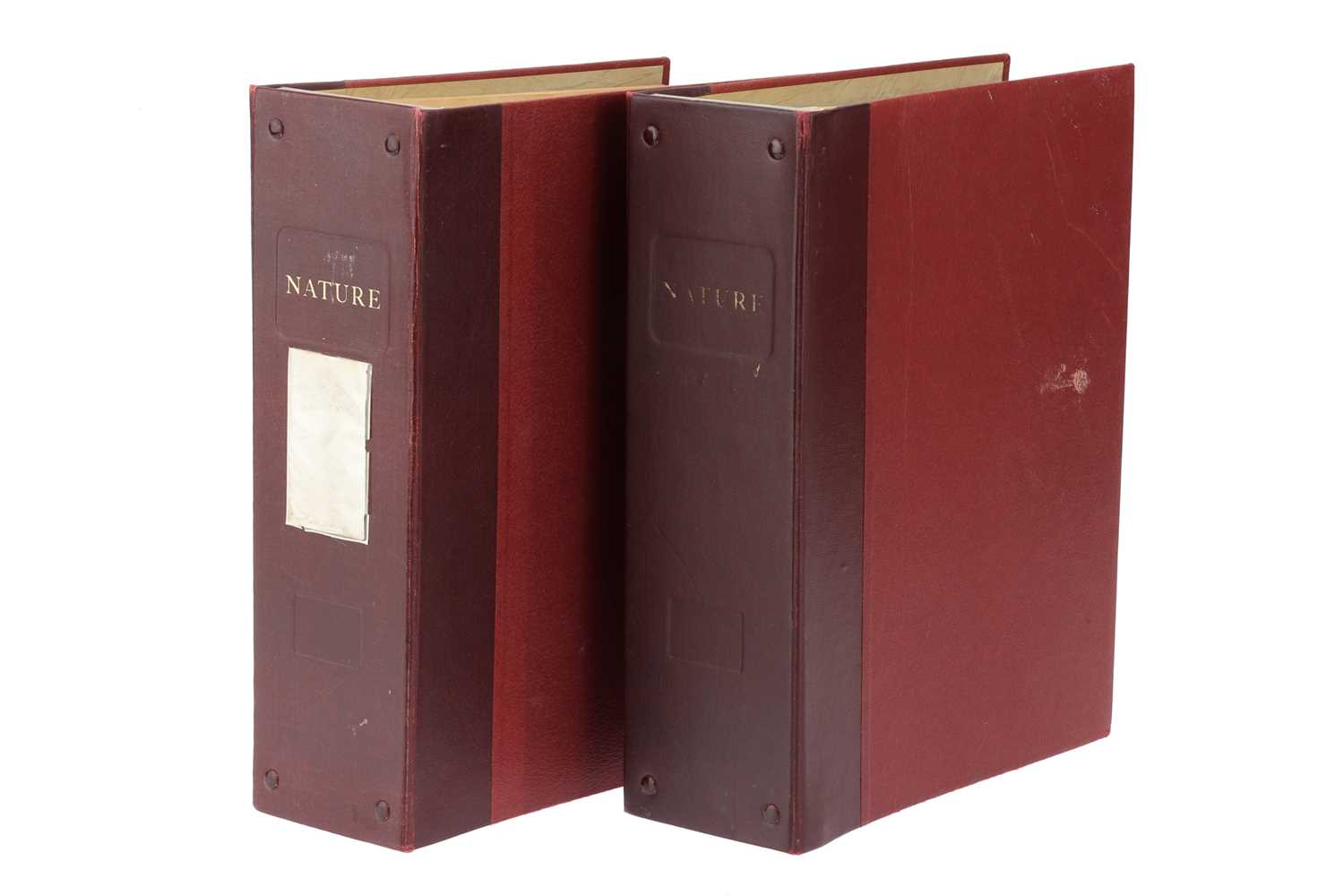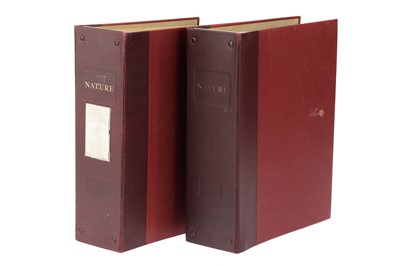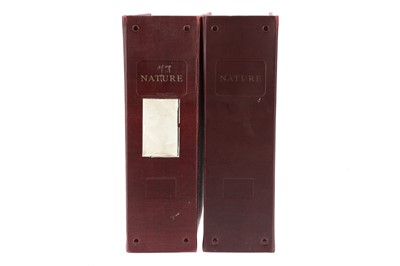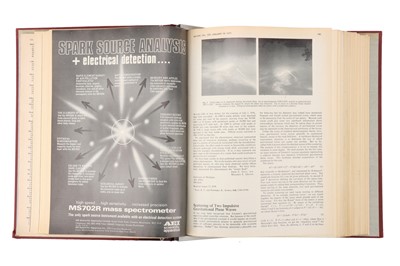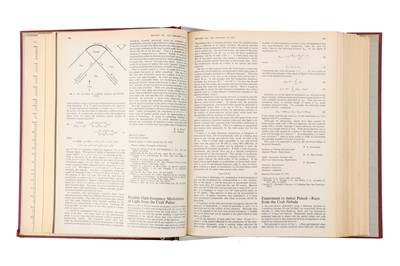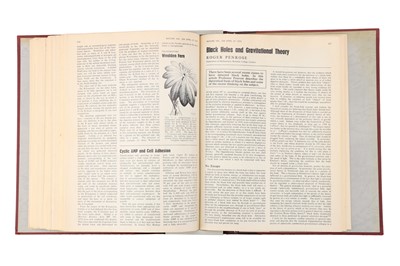24th May, 2023 12:00
Fine Instruments of Science, Medicine and Books
Penrose, Roger, Black holes and gravitational theory, 1972
comprising of:
1 - Nature A Weekly Journal of Science, Volume 236, April 21, 1972, London, Macmillan Journals, Ltd, complete bound journals, with library stamps throughout for 'Strangeways Research Laboratory Library, Cambridge'with first edition, first impression of Roger Penrose's paper: Black holes and gravitational theory [p.377 – p.380]
and
2 - Nature A Weekly Journal of Science, Volume 229, January 15, 1971, London, Macmillan Journals, Ltd, complete bound journals, with library stamps throughout for 'Strangeways Research Laboratory Library, Cambridge' with first edition, first impression of Roger Penrose's paper: Scattering of Two Impulsive Plane Waves [p.185 – p.186]
Sir Roger Penrose is a British mathematician, mathematical physicist, and philosopher of science who was awarded the Nobel Prize in Physics in 2020 for his groundbreaking work on black holes and the nature of space and time. In 1972, he published a seminal paper in the journal Nature titled "Gravitational Collapse and Space-Time Singularities," which has since become a cornerstone of modern theoretical physics.
In his paper, Penrose proposed a new model of gravitational collapse that accounted for the formation of black holes. He introduced the concept of a space-time singularity, a point in space-time where the gravitational field becomes infinite and the laws of physics break down. This idea challenged the prevailing view of black holes as mere mathematical curiosities and helped establish them as physical objects with real-world consequences.
Penrose's work also paved the way for the study of cosmic censorship, the idea that singularities are always hidden behind event horizons and cannot be observed directly. This principle has important implications for our understanding of the universe, as it suggests that the laws of physics are inherently unpredictable in certain extreme situations.
Penrose's contributions to the field of theoretical physics have been widely recognized and have earned him numerous awards and honors, including the Wolf Prize in Physics, the Albert Einstein Medal, and the Royal Medal of the Royal Society. His work has also inspired a new generation of physicists and mathematicians to push the boundaries of our understanding of the universe.
In conclusion, Sir Roger Penrose's paper on black holes and gravitational theory published in Nature in 1972 was a seminal work that revolutionized our understanding of these mysterious objects. His concept of space-time singularities and his work on cosmic censorship have had far-reaching implications for our understanding of the universe and have cemented his place as one of the most influential physicists of our time.
comprising of:
1 - Nature A Weekly Journal of Science, Volume 236, April 21, 1972, London, Macmillan Journals, Ltd, complete bound journals, with library stamps throughout for 'Strangeways Research Laboratory Library, Cambridge'with first edition, first impression of Roger Penrose's paper: Black holes and gravitational theory [p.377 – p.380]
and
2 - Nature A Weekly Journal of Science, Volume 229, January 15, 1971, London, Macmillan Journals, Ltd, complete bound journals, with library stamps throughout for 'Strangeways Research Laboratory Library, Cambridge' with first edition, first impression of Roger Penrose's paper: Scattering of Two Impulsive Plane Waves [p.185 – p.186]
Sir Roger Penrose is a British mathematician, mathematical physicist, and philosopher of science who was awarded the Nobel Prize in Physics in 2020 for his groundbreaking work on black holes and the nature of space and time. In 1972, he published a seminal paper in the journal Nature titled "Gravitational Collapse and Space-Time Singularities," which has since become a cornerstone of modern theoretical physics.
In his paper, Penrose proposed a new model of gravitational collapse that accounted for the formation of black holes. He introduced the concept of a space-time singularity, a point in space-time where the gravitational field becomes infinite and the laws of physics break down. This idea challenged the prevailing view of black holes as mere mathematical curiosities and helped establish them as physical objects with real-world consequences.
Penrose's work also paved the way for the study of cosmic censorship, the idea that singularities are always hidden behind event horizons and cannot be observed directly. This principle has important implications for our understanding of the universe, as it suggests that the laws of physics are inherently unpredictable in certain extreme situations.
Penrose's contributions to the field of theoretical physics have been widely recognized and have earned him numerous awards and honors, including the Wolf Prize in Physics, the Albert Einstein Medal, and the Royal Medal of the Royal Society. His work has also inspired a new generation of physicists and mathematicians to push the boundaries of our understanding of the universe.
In conclusion, Sir Roger Penrose's paper on black holes and gravitational theory published in Nature in 1972 was a seminal work that revolutionized our understanding of these mysterious objects. His concept of space-time singularities and his work on cosmic censorship have had far-reaching implications for our understanding of the universe and have cemented his place as one of the most influential physicists of our time.
